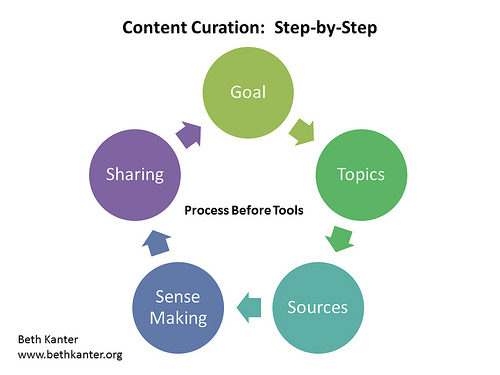 If content is currency, what does that make content curation? We’ve all heard the buzzword thrown around, but let’s take a quick look at what it is and why we need to practice it.
If content is currency, what does that make content curation? We’ve all heard the buzzword thrown around, but let’s take a quick look at what it is and why we need to practice it.
The “why” is simple. There’s just too much unfiltered real-time data floating around. In his article for Fast Company, “Content Curators Are The New Superheros Of The Web,” Steve Rosenbaum, CEO of Magnify.net and author of Curation Nation, praises those who take it upon themselves to become content curators and gives us some numbers to ponder:
Yesterday, 250 million photos were uploaded to Facebook, 864,000 hours of video were uploaded to YouTube, and 294 BILLION emails were sent. And that’s not counting all the check-ins, friend requests, Yelp reviews and Amazon posts, and pins on Pinterest. […]
And while algorithms have gotten better at detecting spam, they aren’t keeping up with the massive tide of real-time data.
In 2010 we frolicked, Googled, waded, and drowned in 1.2 zettabytes of digital bits and bytes. A year later volume was on an exponential growth curve toward 1.8 zettabytes. (A zettabyte is a trillion gigabytes; that’s a 1 with 21 zeros trailing behind it.)
What is content curation? In another article, this time for Mashable, Rosenbaum defines content curation as “a combination of finding great content and following some simple best practices on how to successfully share that content.”
Beth Kanter, an expert on nonprofits and social media, likens content curation to curating an art exhibit. She writes on her blog:
Content curation is the process of sorting through the vast amounts of content on the web and presenting it in a meaningful and organized way around a specific theme. The work involves sifting, sorting, arranging, and publishing information. A content curator cherry picks the best content that is important and relevant to share with their community.

Kanter’s big three cornerstones are “The Three S’s: Seek, Sense, Share.” Rosenbaum’s tips somewhat echo those:
1. Be Part of the Content Ecosystem […] not just a re-packager of it. […] Created, contributed, and collected — the three ‘c’s is a strong content mix that has a measurable impact.
2. Follow a Schedule. Make sure to post at the same time each week.
3. Embrace Multiple Platforms. Today content consumers get their information on the platform of their choosing. That means you should consider posting short bursts on Tumblr, images on Pinterest, video on YouTube, and community conversations on Facebook.
4. Engage and Participate. Make sure you’re giving back by reading others and commenting on their posts.
5. Share. Don’t Steal. Take the time to give attribution, links back, and credit.
Speaking of stealing, Rosenbaum stresses that content curation is, of course, more involved than pushing a share button; and sharing online content also has its set of solid parameters that distinguishes it from stealing. Proper attribution, for instance, is crucial, including obtaining permission for the images or only using the copyright-permissible ones.
Rosenbaum suggests looking at these starting points:
1. If you don’t add context, or opinion, or voice and simply lift content, it’s stealing.
2. If you don’t provide attribution, and a link back to the source, it’s stealing.
3. If you take a large portion of the original content, it’s stealing.
4. If someone asks you not to curate their material, and you don’t respect that request, it’s stealing.
5. Respect published rights. If images don’t allow creative commons use, reach out to the image creator — don’t just grab it and ask questions later.
Gianluca Fiorelli breaks down content curation into five basic types on SEOmoz. Check out his post for some specific examples and a list of tools, but here’s the rundown:
1. Aggregation, which consists in curating the most relevant content about a topic into one single location. This is the most common way of curating content, and it is at the base of the majority of the content curation services actually present online;
2. Distillation, which purpose is to distill the overall noise about a topic to its most important and relevant concept. The best cases of social content curation can be catalogued into this definition;
3. Elevation, when curators draft a more general trend or insight from a mass of daily musings;
4. Mashups, or to merge different content about a topic creating a new original point of view of the same;
5. Chronology, which could be defined as historiographical content curation. Usually it consists in presenting a timeline of curated information to show the evolution of a particular topic.
Looks like the business world is taking note of the amazing growth of companies like Pinterest, moving to adopt content curation as a mainstream practice. According to Curata’s “2012 Content Curation Adoption Survey” results, “95 percent of marketers had curated content in the past six months. Of those respondents that indicated they had not knowingly curated in the past six months, 100 percent of them had, by sharing an article, blog post or other content with a prospect or customer.”
The survey also found that “more marketers cited finding high quality content as their greatest content marketing challenge compared to 2011 (30 percent increase), and three-quarters (75 percent) of marketers indicated that having the time to do it was the biggest challenge.”
According to the MarketWatch press release:
Curata recently found […] that websites that are curated on a daily basis receive 18 percent more click-thru activity than those curated on a weekly basis. Curators understand the value of timely content, and today almost half (45 percent) of them indicated that they share content on a daily basis. This represents an 18 percent increase over the 2011 Content Curation Adoption Survey.
Other interesting findings included:
- Establishing or improving thought leadership continues to be a primary objective of content curation: 8 percent more marketers cited it as their primary objective than a year ago.
- Social media is a preferred channel for both finding and sharing online content: 79 percent of marketers cited social media as their favored method for finding third-party content, and 76 percent responded that social media was their top choice for sharing content.
- Resources are being dedicated to content curation: 50 percent of marketers indicated that there were one or more people at their organization dedicated to curating shared content.
- Three quarters of marketers who identify themselves as content curators dedicate up to 25 percent of their marketing budgets to content curation.
It would be interesting to see how the “rules” and best practices of content curation evolve in a year or two, and what tools will come out on top.
Image of Flash is by mondi (Ramos Alejandro), used under its Creative Commons license.
Content curation graph by Cambodia4kids.org (Beth Kanter), used under its Creative Commons license.